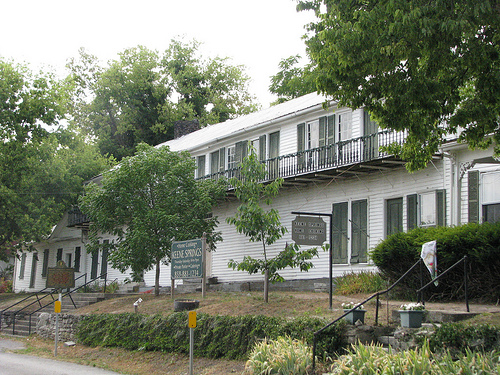 |
| Keene Springs Hotel – Keene, Ky. |
During the cholera epidemics of 1833 and 1849, Lexingtonians feared the deadly disease. Five hundred souls perished out of a population of just 7,000. Many of the dead were buried by the now infamous King Solomon. While King Solomon can thank his alcohol-filled veins for keeping him alive during the epidemic, many of the survivors did so by leaving Lexington. But where did they go?
Wrote Bennett H. Young in his 1898 History of Jessamine County, Kentucky: “during the prevalence of cholera, in Lexington, about this time, a large number of people came to Keene and lived during the panic, occasioned by this disease in Lexington and surrounding towns.” They stayed in “a very nice hotel.”
 |
| Keene Springs, ca. 1868 (Source: KDL) |
The Jessamine County community of Keene prospered during each of Lexington’s two epidemics, but it was during the second epidemic that the Keene Springs Hotel truly succeeded due in part to the 1848 discovery of the area’s “white sulphur water.” Declared by the dean of Transylvania’s Medical College, Dr. Robert Peter, as “incomparably the best medical water on this continent … eminently adapted to the cure of every species of Indigestion, Liver Complaint, Dropsy, Scrofula, Cutaneous Affections, Mercurial Diseases, a variety of Nervous Diseases and nearly all diseases that are usually denominated chronic.” Yes, the ails plaguing Lexingtonians could be cured by the medicinal springs in nearby Jessamine County. And while Kentucky boasts other natural mineral springs, none was quite as close to Lexington as Keene.
William Cleveland sold the resort hotel in 1841 to Mason Singleton, the grandson of the pioneer who first settled the community of Keene. Singleton retain Capt. G. L. Postlethwait to manage the facility which he greatly expanded with a ballroom and banquet hall. By 1857, however, Singleton was forced to sell the hotel. Alfred McTyre purchased the Keene Springs Hotel and operated it for a decade before he sold the hotel to Fielding S. Wilson. By this time, the resort’s popularity had waned. Though Wilson had a few occupants from time to time, operation was largely confined to a general store and, until liquor prohibited by local vote, a saloon. A general store continued to operate until the 1960s and the Wilson continues to own the building. Today, slow restorations are underway by a tenant operating a restaurant three days a week in this history locale.
More photos of the Keene Springs Hotel are available on flickr.
Sources: Bennett Young’s History; Jessamine Journal; National Register Application; RootsWeb
